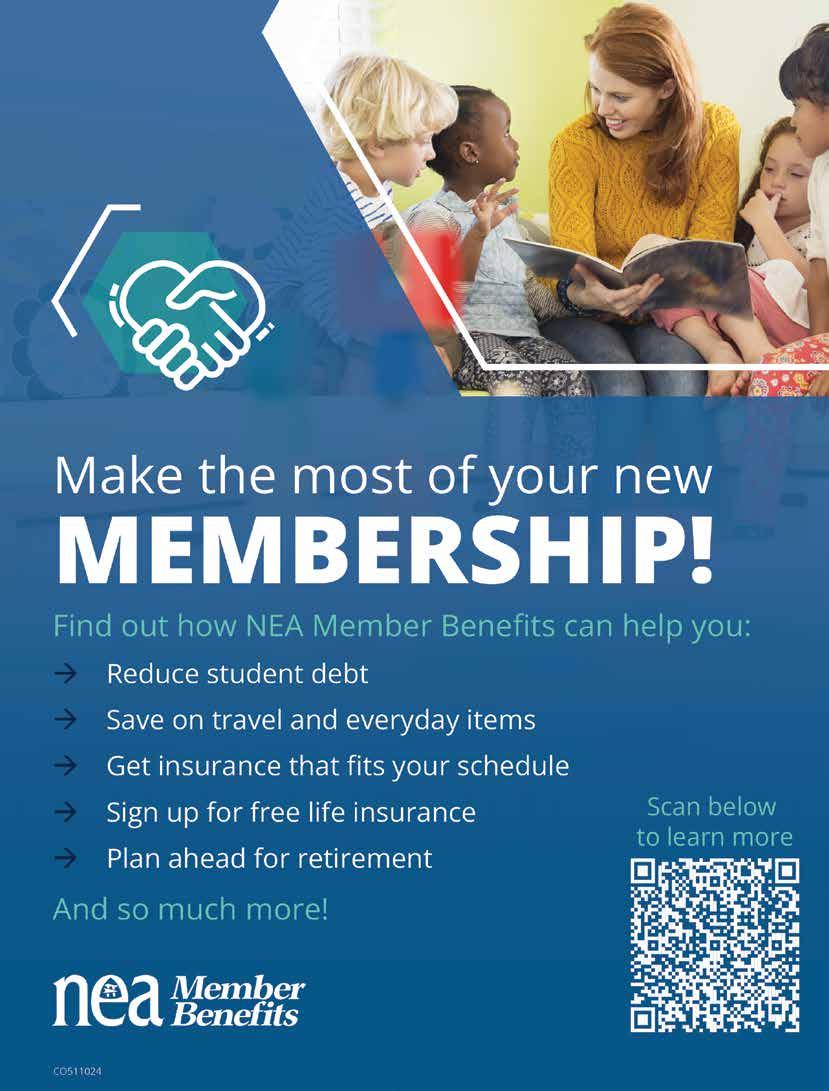EDUCATI N


































The magazine of the Virginia Education Association







































































































































































































Up: Students say and do the funniest things.


























































































Cracking Us Up: Students say and do the funniest things.

4-7 This month: Ten more commandments, warning labels, and Touching Base With Milondra Coleman of Richmond.
13 Support Professionals: Tune In for Professional Growth! Webinar recordings from the NEA’s ESP Learning Network are available online.
14 Why We Need the Arts in Our Schools The ‘soft skills’ young people learn in art class translate across the curriculum and beyond classroom walls.
17 It Pays! Why financial literacy is vitally important for high school students.
20 Membership Matters Summer school, a national award winner, and more.
24 Insight on Instruction The many hats a teacher wears, the human element, and more.
30 First Person Help a new teacher this fall.
Editor
Tom Allen
VEA President
Carol Bauer
Interim VEA Executive Director
Dr. Earl Wiman
Communications Director
Kevin J. Rogers
Graphic Designer
Lisa Sale
Editorial Assistant/Advertising Representative
Kate O’Grady
Contributors
Milondra Coleman Bruce Ingram
Andrea Eisenberger
Alice Stocks
Joy Kirk
Vol. 117, No.1
Copyright © 2024 by the Virginia Education Association

“The sarcastic remarks, the smirks…don’t take them personally. It’s just my brand.”




The Virginia Journal of Education (ISSN 0270-837X) is published six times a year (October, November, December, February, April and June) by the Virginia Education Association, 8001 Franklin Farms Drive, Suite 200, Richmond, VA 23229.
Non-member annual subscription rate: $10 ($15 outside the U.S. and Canada). Rights to reproduce any article or portion thereof may be granted upon request to the editor. Periodicals postage paid in Richmond, VA.
Postmaster: Send address changes to Virginia Journal of Education, 8001 Franklin Farms Drive, Suite 200, Richmond, VA 23229.
Article proposals, comments or questions may be sent to the editor at tallen@veanea.org or Tom Allen, 8001 Franklin Farms Drive, Suite 200 Richmond VA 23229 800-552-9554.
Member: State Education Association Communicators
VEA Vision:
A great public school for every child in the Commonwealth of Virginia.
VEA Mission:
The mission of the Virginia Education Association is to unite our members and local communities across the Commonwealth in fulfilling the promise of a high quality public education that successfully prepares every single student to realize his or her full potential. We believe this can be accomplished by advocating for students, education professionals, and support professionals.
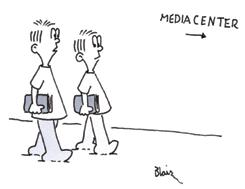
“Do you think teachers have first names?”
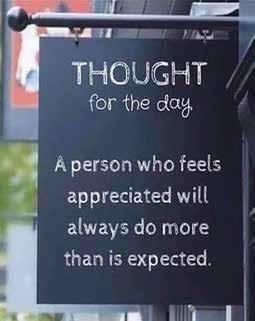
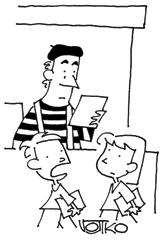
Earlier this year, Louisiana became the first U.S. state to pass a law requiring the posting of the Ten Commandments in its public school classrooms, a move that seemed to fly in the face of the concept of the separation of church and state. In response, Dr. Robert Klitzman, a psychiatry professor who directs the Bioethics master’s program at the Columbia University School of Professional Studies, suggested 10 other “commandments” that could also play an important role in shaping the moral education of our young people:
• Thou shalt think of future generations.

• Thou shalt respect the Earth, avoid contributing to climate change, and use alternative energy sources.
• Thou shalt work toward world peace.
• Thou shalt consider the greater social good, not just thine own personal benefit.
• Thou shalt consider the poor and disadvantaged.
• Thou shalt respect those with whom thou dost disagree.
• Thou shalt consider all the facts and not just cherry-pick them.
• Thou shalt consider the long-term, not just the short-term, implications of thine own actions.
• Thou shalt accept responsibility for thine own actions and not just blame others.
• Thou shalt question thyself and think critically about thy viewpoints.l
Source: The Hechinger Report (hechingerreport.org)
An essential mindset when your classroom has students with complex learning or developmental needs is understanding the important difference between, “inclusion” and “belonging,” says Erik Carter, executive director of Baylor University’s Center for Developmental Disabilities.

Inclusion, he says, is often used to mean that students with disabilities are “just being present,” while belonging is “more about how we see one another and the relationships formed within those activities in which we are present.”
The difference is meaningful because students who feel like they belong are more excited to be in school and more likely to be there every day, he points out.l
She’s an endless fund of energy and viability. (Can’t stay in her seat for five minutes).
Fantastic imagination! Unmatched in his capacity for blending fact with fiction. (He tells more fibs than anyone I’ve ever met.)
Exhibits a casual, relaxed attitude to school, indicating that high expectations don’t intimidate her. (Hasn’t done an assignment yet.)
His athletic ability is marvelous. Superior hand-eye coordination. (The little creep hit me with a rubber band from 15 feet away.)
Always amazed at her tenacity in retaining her youthful personality. (She’s incredibly immature.)
Unlike some students who hide their emotions, he’s very expressive and open. (He must have written the Whiner’s Guide.)l
Source: gcfl.net

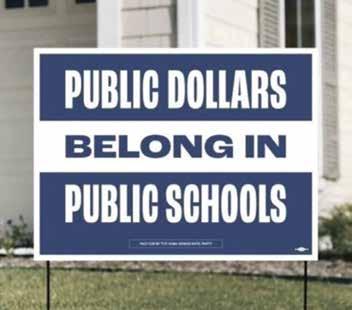
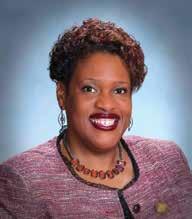
MILONDRA COLEMAN
RICHMOND EDUCATION ASSOCIATION
High school government and history teacher
What’s something you like about your job?
I love working with different students every year and helping them cultivate a love of history. Additionally, it is my absolute honor and pleasure to teach my students content that will help them be better global citizens.
How has being a VEA member helped you?
Being a VEA member has helped me sharpen my teaching skills through powerful professional development opportunities. Also, I am beyond grateful that being in VEA has allowed me to meet and collaborate with phenomenal educators across the Commonwealth. l
Here are what U.S. teachers called the three top challenges students face in our public schools today, in a survey last school year by the Pew Foundation:
• Poverty (named by 53 percent of respondents as a “major problem”)

• Chronic absenteeism (49 percent)
• Anxiety/depression (48 percent) Bullying was next at 20 percent, though it registered at 34 percent with middle school teachers.l
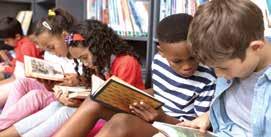
What a school thinks about its library is a measure of what it feels about education.
— Harold Howe
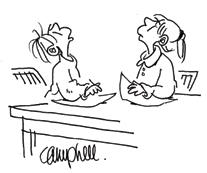
“Those
One of the most important lessons I learned in medical school was that in an emergency, you don’t have the luxury to wait for perfect information. You assess the available facts, you use your best judgment, and you act quickly.

The mental health crisis among young people is an emergency — and social media has emerged as an important contributor. Adolescents who spend more than three hours a day on social media face double the risk of anxiety and depression symptoms, and the average daily use in this age group, as of the summer of 2023, was 4.8 hours.
It is time to require a surgeon general’s warning label on social media platforms, stating that social media is associated with significant mental health harms for adolescents…Evidence from tobacco studies show that warning labels can increase awareness and change behavior. To be clear, a warning label would not, on its own, make social media safe for young people. The advisory I issued a year ago about social media and young people’s mental health included specific recommendations for policymakers and platforms, and such measures remain the priority.
The moral test of any society is how well it protects its children… We have the expertise, resources and tools to make social media safe for our kids. Now is the time to summon the will to act.l
op-ed column in The New York Times in June.
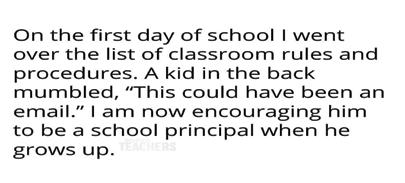

“While we want to wrap our kids in bubble wrap and make their worlds perfect, we do them no favors if we shield them from all discomfort. What we want to do is give them tools to be resilient so that they are able to bounce back from a low grade, getting cut from a team, flubbing a line in a play, or sending a text they thought would be funny but that landed mean: All of those things that are part of growing up.”l

— Phyllis Fagell, a Washington, DC-based school counselor and the author of Middle School Matters: The 10 Key Skills Kids Need to Thrive in Middle School and Beyond—and How Parents Can Help.

“You want me to answer your question? In real time?”
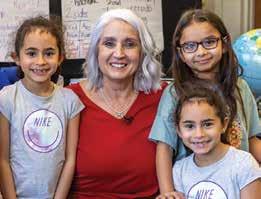
“I want our policymakers to know what’s going on inside our classrooms. For far too long, policy has been made by people who are not education experts. They’re not teachers, they don’t spend a lot of time within classrooms. But we’re not going to make anyone aware unless our teachers are willing to speak up and be advocates — for their students, themselves, our profession — by being honest about what our struggles are, and what will make those struggles better.”
— Missy Testerman, an ESL teacher in Tennessee and the 2024 National Teacher of the Year.l
Students say and do the funniest things.
We choose to work with young people because we see their potential, we want to help them succeed, we see their need for trusted adult guidance, and we want to ensure a better future for all of us.
And because they’re flat-out hilarious sometimes.
When school staff members gather, the topic often turns to questions like, “What did your kids do today?” What follows frequently leaves our sides hurting from all the laughter. To help kick off a new school year, we asked some Virginia educators to share some of the episodes that still make them laugh when they look back at them. Here’s a sampling of their responses:
Quite Shocking
First-graders at the school where I taught were practicing manuscript writing and also learning about Ben Franklin. To hone their skills in writing paragraphs, they were using the four-square method, in which they would write one sentence in each of the four corners of their papers. These four-square paragraphs were destined for display in the hallway outside their classroom. One enterprising student, in his best writing, set down highlights of Franklin’s life in four sentences.
In the first corner, he wrote, Benjamin Franklin was born in Boston. In the second, Benjamin Franklin moved to Philadelphia. In the third, Benjamin got married. And for the final corner, he added,
Then Ben discovered electricity.
— Joseph Marler, retired, Bristol
History-Making Quotes
I do a quote board in my classes every year (I teach choir to students in grades 6-12) and here are some of my favorites from this past year:
• “Is crying allowed during karaoke?”
• “A bunch of boys came in here and Mojo Dojo Casa House’d our Barbie Dream House!”
• “Study hall!? Today!? In this economy!?”
• “She’s so cute when she’s on the brink of insanity.”
• “That song is a banger. And I know bangers.”
• (Student telling us the story of
how she broke her ankle.) “So, I was chasing down this particularly obese cat named Max. Max hates me. I hate Max.”
• “I was up doing my 3 a.m. shenanigans.” “What are 3 a.m. shenanigans?” “That’s between me and the cops.”
• “And I think that says a lot about my childhood.”
— Katie Seidemann, Montgomery County
Um, That One’s Not on the Shelves One day when working in the library, a first-grader came bounding up to me and, with great excitement, asked if we had any “Fasty Nasty” books. Puzzled, my assistant and I looked at each other—and then it dawned on me. “Do you mean Fancy Nancy?” I asked. “Yes!” she said. I’m guessing Fasty Nasty is a whole different character…
— Mary Beth Utley, Henrico County
The Band Goes on Tour
• During hotel room checks on a band trip, some students told me their microwave wasn’t working. What they showed me was not a microwave – it was a safe. For valuables and jewelry. Despite locking their food in there, it was not, in fact, warmed up at all.
• A student returned a health care form where, under food restrictions, “no alcohol” had been written. Well, there went our plan for strawberry daiquiri snack breaks.
• A parent was hesitant to sign
up their child for our five-day trip to perform in Florida. They wanted to know if any staff members would be on the trip. I was tempted to tell them, “Nope, we just wave goodbye to the charter buses and hope the kids make it back.”
— Kathleen Jacoby, Fairfax County
An Eye-Opening Development
One of my sixth-grade boys was having problems with his recently acquired glasses. He’d noticed that the part of the frame over his ear had become separated from the lens portion. I saw him holding his glasses carefully at an angle and asked him why. He said he was afraid that the “prescription” would run out of the glasses since the earpiece was detached. We sat down for a little chat about his fears and he explained that when he picked out the frames his vision was not corrected, but when he went back to pick them up later they had put the “medicine” in the glass portion and he knew his mother would be upset if it leaked out.
— Helen Wood, retired, Henrico County
Is There a Medal for That?
Years ago, my now-husband was in the Navy and was my class’s pen pal. He returned from deployment, having just earned a promotion to the next rank, and my second-graders planned a celebration. A sweet student and I met him at the front of the school to escort him to the classroom. We saw the principal on the way down the hall and with all of the pride a second-grader could
muster, the student introduced him, saying, “This is our friend. He just got perverted!”
— Jessica Early Meier, Chesapeake
Soviet Slapstick I taught the novel Animal Farm to ninth-graders for almost 40 years. Since it’s a dystopian allegory based on the Soviet Union, I found that students enjoyed it more after learning some basic Russian history. So, before starting the book, I assigned brief research presentations to practice research skills and gain background knowledge. I also required a visual aid and, since this was before the PowerPoint age, most students chose a poster. One memorable student created a poster about Karl Marx, using a list of less-than-informative handwritten text and photos copied from encyclopedias. At the top was a large photo of Marx. Underneath was another large photo, this one of Karl’s brothers: Groucho, Harpo, Chico, and Zeppo. I kept the poster for many years as a warning about the dangers of procrastination.
— Chip Carter, retired, Henrico County
Probably Not a Future Zookeeper
Me: “Hey! Would you like to see the new classroom pet?”
Kindergarten student: “I’m a little nervous. I would like to try.”
Me: “Thank you for being brave.”
(We walk to small cage on the back counter.)
Me: “Look! They are called guinea pigs!” Student: (gasps) “No thank you! I would not like to see the squirrel pigs anymore. I’m all done.”
— Kelley Green, Virginia Beach
One day after completing some work with clay with my elementary art students, I told them that the projects would dry and then I would fire them in the kiln. One student raised his hand and asked where the kiln was. pointed to the room adjoining my classroom and opened the door so the students could see the kiln. The student then said, “Oh, we thought you lived in that room.” (I had to explain that I was married, had two children, and lived in a house just like they did).
— Julie Aittama, retired, Shenandoah County
Now that’s High-Energy Teaching!
• I used to drink water from a stainless steel water bottle in my classroom, and I guess my students never saw or noticed me refilling it.
One day, however, they did, and “John” asked, “Do you have another bottle for your coffee?”
“No,” I said. “All I drink is water. I don’t like coffee.”
Surprised, he replied, “Really? Because you act like it’s coffee.”
• Another of my students, “Tina,” repeatedly asked if she could go to the office to call her mom so she could remind her that she had a doctor’s appointment that afternoon. I kept telling her that her mom would surely remember. The last time I said it, “Tina” replied in an exasperated tone, “But you don’t understand, she’s a good forgetter.” I sent her to call her mom.
— Tracie Mercier, retired, Bristol
Adventures with Kindergartners…
• My classroom had a bathroom, which was very handy and
door that was green on one side (GO) and red on the other (STOP) and the children would flip it accordingly when they entered and left the bathroom. One day a student (5-year-old boy) was taking an especially long time in the bathroom when I heard him loudly calling out, “At home I get a double check on wiping!”
• During journal time I would have music playing softly in the background as the children worked, hopefully sparking some creativity. One day, a child turned to her tablemate and announced, “My mom likes sexy, take-yourclothes-off songs!”
• A kindergarten teacher teammate of mine was having “Share Day” (Show and Tell) with her class. One of her students proudly revealed that he had brought in the remote control to his family’s TV set; he had, in fact, brought in a packet of his
(They did look like a dial…)
— Mary Lynn Taylor, retired, Henrico County
Old Souls?
I’ll call these two feisty three-yearolds Tee and Chi. On Valentine’s Day we were reading the book Arthur’s Valentine in our preschool class, and I asked them a question. Tee stood up and said, “Chi is my Valentine, and she is cute.” Chi smiled and responded, “He would be my Valentine, too, if he didn’t annoy me so much.” Later that day we were doing an art activity and they were arguing with each other: “Chi, stop being mean and nagging me.” “Tee you don’t listen to word I say.” They came up to me: “Tee is being annoying.” “Chi is being a big old nag.” I said, “Friends it sounds like you both have a problem.” They looked at me and said, “Mr. Turner, we need a break from each other. Maybe we need to play with other people.” Now I was trying my hardest to keep a straight face and not bust out laughing because these two argued like a married couple. The relationship challenges continued through nap time and dismissal. Chi woke up first, walked over to a sleeping Tee with her hands on her hips and said, “Tee Matt Jr! Naptime is over! Wake up now!” Tee rolled over and said, “Go away woman! need
one more minute.”
— Darrell Turner, Richmond
A Pretty Lax Dress Code
A high school freshman boy sitting in the back of my science classroom stood up one day and pulled his shorts down. I was so stunned that I couldn’t do anything at first but stutter. “What?!” he said. “I have another pair on!”
— Former VEA President Meg Gruber, retired, Prince William County
Couldn’t Have Said It Better
Ourselves
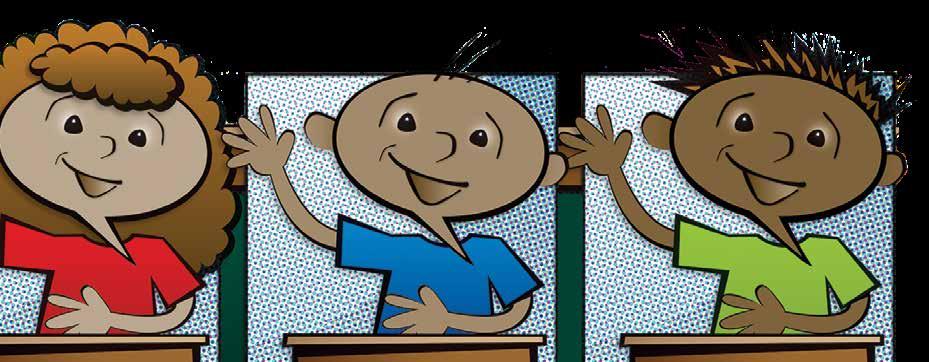
introduction to colonial government, there was a reference to colonists having the same rights as “Englishmen,” a word some of the kids didn’t recognize. I asked the class for some thoughts on the term and one girl immediately piped up, “Oh, Mrs. Steele, I love Englishmen! I just want to drizzle them with honey and go crazy.” The rest of the class got pretty uncomfortable (as you might imagine), but being a seasoned middle school teacher, I didn’t even miss a beat: “Do you mean English muffin?” I asked. Of course, that’s exactly what she meant.
— Sarah Anzelmo-Steele,
Richmond
I had a student who, in the first two weeks of school after COVID, hit one student at recess and kicked another. Not long after, she moved to another school. A year later I received an email from her, saying that while it was likely I didn’t remember her, she wanted to apologize for being so bad during the short time she was in my class. She signed it Sinceriously, and then her name. My team and I thought that was such a great word that we used it as our Team Name and in other ways throughout the year.
— Alexa Severo, Loudoun County
Well, that was Awkward
When I taught eighth grade, I introduced new units by previewing content and letting the kids go through it in order to identify words they didn’t know. The idea was that if one kiddo didn’t know a word, then likely multiple others didn’t know it, either. We’d then use context clues and the collective knowledge in the room to try to create a definition. As we did the
Impromptu Civics
In my Civics/Economics class we do quick checks periodically to measure growth, sometimes using a strategy called Fast & Curious. The students get very competitive, both to beat their previous class scores and to compare to other classes. In one class, I asked if I could play the gimkit, too. The kids all yelled “NO!” but then one realized my score would help the class average and yelled, “Wait! She can help us win!” said, “Sorry, the class has already voted.” He stood and said, “I demand a recount!” I laughed and asked if he had a second to support his motion. He looked at his tablemates and friends and another boy said he’d second. I then formally addressed the class and said, “A motion to reopen the previous vote has been moved and seconded. All in favor?”
The majority of students yelled “Yes!” and “Aye!” I declared the vote reversed and grabbed my phone to play the game. I heard a student say, “Ah yes, democracy at its finest,” to which his tablemate replied, “Absolutely! And I am here for it!”
— Erin Merrill, Prince William County
by

A Long Way Up
A kid came back to class after having asked for permission to go to the bathroom. I thought he was back too quick, asked him about it, and he told me he couldn’t reach because the toilet is too tall. It was then that I realized why the toilet in the staff restroom often had a wet seat. Littles are not used to the larger multi-toilet bathrooms in the hall and apparently had been using the staff room. That place needs keypad entry!
— Heather Ashley, Shenandoah County
‘Fame’ is Relative…
During a Black History Month celebration, my kindergarten children were supposed to dress up like a famous African American. We had talked about all the ones they could think of, and I talked about others on TV and sports, etc. Well, when the day came, they all came in looking like some of the famous people we talked about, and I could recognize
Puzzling Botany Question
Conversation between two high school freshmen:
Student A: “Hey, did you know tomatoes are fruits, not vegetables?”
Student B: “Then why were they on Veggie Tales?”
Amanda Lambert, Chesapeakel
Webinar recordings from the NEA’s ESP Learning Network are available online.
all of them but one. This little girl was dressed in heels, skirt, sweater, and glasses with her face all made up. I asked her if she was Oprah or Michelle Obama and she said, “No, I’m you, Ms. McDowell. Don’t I look like you?” Laughing I said, “You sure do. We look like twins.” She went around all day asking teachers and other people, “Don’t I look like Ms. McDowell?” I thought it was the cutest, and it made me so happy to know she thought I was a famous African American.
— VEA-Retired President Lola McDowell, Richmond
The Astounding Lifespan of the Average Teacher
During a history film the class was watching, Bull Run was mentioned. I told my students that I’d once lived near Bull Run Creek.
“Did you know Abraham Lincoln?” one asked.
— Shawn Evans MacDougall, Chesapeake
The following item was contributed for this story and while it’s not high on comedy, it’s high on compassion, so we decided to include it:
In a third grade classroom, completing a student observation for an eligibility meeting, I witnessed one of the sweetest acts of kindness I’ve ever seen. Students were writing their weekly spelling words in their best handwriting (names only on the back), and the teacher taped their work to the board. Then she gave each student three smiley-face stickers to place on the ones they thought were the best.
One student, among the last ones to place his stickers, looked at the papers and saw that one had none attached to it yet. He paused and put his first sticker on it, not knowing whose it was, just wanting them not to be without a sticker.
For a third-grader to have that much kindness, insight, and compassion made me proud to be a human.l

For several years, NEA’s ESP Quality Department has been producing webinars to support the professional development and growth of school support staff, regardless of their roles. If you haven’t had a chance to catch any of them live, worry not! Recordings of the sessions are available on NEA’s website (link below). Here is just a sampling of some of the programs available, and they offer professional development certificates (instructions are on each recording). Take a look and start building your personal library of knowledge:
Culture: Communication skills are critical to supporting positive student behavior: How you communicate with students during times of crisis or challenging behaviors can impact students’ level of de-escalation. This webinar offers foundational information on verbal intervention, phases of de-escalation, and positive communication skills. You will learn
Using Your Authentic Voice to Galvanize and Inspire: Nothing makes a point or can change someone’s point of view like a good story, and educators have the best stories. Here, you’ll explore ways to use stories from your experiences as ESPs to help advance student success, public education, and the education profession. Join us to learn how personal stories have the power not only to change attitudes, perceptions, and behavior, but to win support for public education.
effective de-escalation strategies that ESPs can use to help support students and aid in creating a positive school culture.
Financial Wellness: An Educator’s Guide to Managing Money: Learn how to build a budget that works, use strategies for goal-setting and eliminating debt, improve your credit score, and manage risk.
Building Authentic Relationships as ESP Leaders: ESPs have the power to make important and meaningful change by building meaningful connections with everyone in the school community including teachers, specialized instruction support personnel (SISP), students, and families. You’ll hear from Pamella Johnson, Academic and Behavioral Intervention Specialist and 2023 NEA ESP of the Year, and learn the importance of building authentic relationships, how to make these connections, and how to empower other ESPs to become more engaged in their roles as leaders and professionals.
A National Snapshot of ESP Wages and How to Advocate for a Livable Wage: You don’t need anyone to tell you that ESPs are underpaid. Recent data shows that ESPs, on average, earn at least $10,000 below a basic living wage in every state of our country. Learn from NEA ESP Quality and Collective Bargaining and Member Advocacy staff, who will walk you through the new 2023 ESP Earnings Report data and share information on how you and your colleagues can advocate for livable wages for ESPs. Team Building for All Educators: This is a thought-provoking webinar that will empower you with the skills you and your colleagues need to build a truly effective team. It offers a holistic approach to NEA’s Leadership Competencies with a specific emphasis on “Leading Our Profession,” supplemented with “Communication” and “Advocacy.” You will learn to engage others by identifying strengths and strengthening weaknesses and then identifying roles that players have on a team to promote team success, as well as engaging in activities that require you to think critically and solve problems as a team.
To learn more about these and a full lineup of other ESP Learning Network webinars, visit www.nea.org/ esp-webinar-recordings l

The ‘soft skills’ young people learn in art class translate across the curriculum and beyond classroom.
By Andrea Eisenberger
“Creativityis intelligence having fun,” Albert Einstein once said, and I think that idea encapsulates both the joy and the challenges we face as educators in the fine and performing arts. On one hand, we have the privilege of cultivating skills that transfer to all other areas of life, such as critical thinking and cultural awareness. On the other hand, our subjects are often
deemed less important than “core” academic subjects that are measured by standardized tests. But art classes in no way lack rigor, high standards, or value to the overall curriculum. In fact, the arts should be considered an essential part of every student’s education because they foster both imagination and critical skills young people need to succeed.
In the school division where I
work, we have a “Graduate Profile” outlining the skills our students need to have to be future-ready, including problem-solving, resiliency, crosscultural competency, and personal responsibility. These skills prepare our students for whatever comes next, whether it be college or career—and this is where the arts truly shine.
Those of us in arts education know we’re not necessarily preparing future artists, musicians, actors, and dancers. Some of our students will go on to pursue a career in the arts; the vast majority will not. However, the many intangible skills learned in fine and performing arts classes will carry them across subjects and into adulthood. Often called “soft skills,” what they’re learning in arts classes “comprise a broad spectrum of personal qualities that may be learned through life experience and specialized training,” according to the Brookings Institute. Exposure to the arts has a far greater impact on student learning than just learning how to draw or play an instrument.
In my 13 years as an art teacher, I’ve witnessed truly magical moments as students learn a new technique or successfully experiment with an art process. They frequently tell me how much fun they think art class is or that it’s their favorite subject. I earnestly believe they feel this way not because of me, but because art class enables them to explore, imagine, and create in ways that other subjects don’t necessarily allow.
As with any skill, soft skills don’t just develop on their own. They require frequent practice and guidance in how to use them, and art class is the perfect place to do just that. Here are some of the skills my students practice regularly:
• Creativity and Innovation: Art education encourages students to think differently. I work hard to build students’ creative skills by using creativity challenges, drawing games, and artist’s choice activities, where they choose what they make and how they make it. By focusing more on the process of making and not on the outcome, students have the freedom to develop their own ideas (which, let’s be honest, are usually way better than what I plan for them).
• Critical Thinking: Students must consider multiple perspectives when engaging with art, which helps develop critical thinking skills. Whether it’s thinking through the steps of the creative process or analyzing an artwork for meaning, art encourages students to think deeply and make connections to real life. I frequently use Harvard University’s Project Zero Thinking Routines in my classes to challenge my students to not just look at art (including their own) but to think about the meaning behind the work.
• Emotional Expression: Social-emotional learning is a big topic in education today as we focus on student mental health. For many students, the art room itself feels like a safe space. In addition to the calming nature of coloring or doodling, art can help students explore how they feel. Some students may even be more comfortable creating art about how they feel than writing or talking about it. Art gives them a healthy outlet for expressing their emotions and personal experiences.
• Cultural Awareness: One of my favorite parts of my practice is introducing students to art and artists from different cultures and historical periods. Global competency is an important skill in our ever-connected world, so it’s essential that students are given opportunities to develop cultural understanding and an appreciation for others. Veering outside of the typical whitewashed canon of art history can be empowering for students of color who may not be accustomed to seeing people who look like them represented in visual art. It can also develop empathy and respect for diversity among students who may not have the opportunity to interact with people who are different from them.
• Visual Literacy: Literacy isn’t a skill that applies only to words. We live in a world where students must continuously make sense of visual information at a fairly rapid pace. Learning to analyze and interpret artworks helps students learn the skills necessary to do this in their everyday lives.
• Fine Motor Skills: So much of what is done in art class is created by hand; therefore, students are able to develop their fine motor skills like cutting, tearing, and gluing. As they draw, paint, and sculpt, they’re strengthening muscles in their hands and improving their handeye coordination and dexterity.
• Collaboration and Social Skills: While don’t rely on traditional group projects in my classes, we do spend a great deal of time working together in other ways. I use collaborative learning strategies like “think-pair-share” and small group discussions to help students develop teamwork and communication skills. Sitting at tables allows the students to give each other real-time feedback while creating, and some students will even organically make artwork together.
• Historical and Social Context: Art education provides insights into historical events, social issues, and personal narratives, helping students understand and engage with the world around them. Visual learners, in particular, really benefit from interacting with a piece of art that conveys a story. Being able to see a depiction of a person, place, or thing from a different time or place can give a deeper understanding of the larger concepts students are trying to learn. This goes handin-hand with cultural awareness, and the importance of
• Confidence and Self-Esteem: wish I could fully put into words what it’s like to see the look of pride on a student’s face when they overcome challenges to complete a work of art. There is truly no better feeling. Creating art can boost students’ confidence and self-esteem and encourage persistence and resilience. Art class is a fantastic and safe place to make mistakes. We talk frequently about how part of the creative process is failing at something and then working through how to get the desired result. We also talk about how the process of creating can give us unexpected but remarkable results. Being able to explore and go with the flow are invaluable lifelong skills.
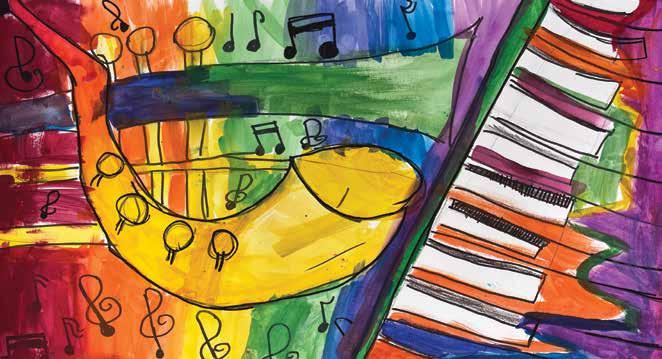
exposing students to a variety of art from different times, places, and cultures.
• Community and Identity: Art can help build a sense of community and personal identity, connecting individuals with their heritage and surroundings through creative expression. Art can also make people aware of important social issues. By engaging in artmaking steeped in social justice or civic engagement, students learn they are part of a world much larger than themselves.
This list is by no means comprehensive but is meant to shine a light on the role of art education in a well-rounded program. And while it focuses on the visual arts, dance, music, and theater also provide opportunities for students to practice many of the same skills. However, we can’t rely solely on fine and perform-
ing arts teachers to cultivate these skills in students. With the increasing importance employers place on intangible skills, students should be trained in them in all areas. One way to do this is to integrate art activities into all parts of the curriculum.
Integrating arts-related activities into academic subjects will help build a solid foundation of soft skills and enable students to make connections across disciplines. Additionally, integration enhances learning by making abstract concepts more accessible. Some suggestions for integration: using visual aids in science and math, illustrating stories in language arts, and using artifacts to connect social studies concepts to real life. Even the use of technology to create presentations incorporates creativity and critical thinking as students navigate how to present information in a clear and readable way.
The integration of fine and performing arts into education isn’t
merely an enrichment of the curriculum but an essential component that nurtures a wide array of skills necessary for students’ holistic development. From fostering creativity and critical thinking to enhancing emotional expression and cultural awareness, arts education equips students for today’s complex and interconnected world. As an art educator, my mission goes beyond teaching artistic techniques; I aim to cultivate well-rounded individuals who are resilient, innovative, and empathetic. By recognizing the profound impact of arts on student learning and personal growth, we can all ensure that the arts remain a vital part of every student’s educational journey, preparing them for the diverse challenges of the future.l
Eisenberger, a member of the Virginia Beach Education Association, teaches art at Three Oaks Elementary School and is the 2024 winner of the VEA’s Award for Teaching Excellence.

Why financial literacy is vitally important for high school students.
By Alice Stocks
During the winter of 2009, while monitoring study hall, my professional life changed. My department chair asked if there was a class not currently on the schedule that I ‘d be interested in teaching and I immediately said, “Yes!” I’d been thinking about conversations I’d had with some of the study hall students concerning life after graduation and saw that they were completely unprepared for the financial responsibilities of living independently. Teaching them financial lessons would help prepare them for their future. However, I couldn’t give assignments in study hall; after all, it was for working on missing assignments or getting additional assistance.
So, I had an answer for my department chair: I wanted to teach Economics and Personal Finance, a course focused on important life skills students can apply immediately.
Each school year, I tell students that they are already savvy consumers; they just may not have learned the terminology to match their actions. I explain that this class is foundational to understanding how the world operates, because it covers the principles that govern markets, trade, and the allocation of resources. It provides insights into how economies grow and develop, and the impact of government policies on economic health. Personal finance, on the other hand, equips people with practical skills to manage their own financial lives, such as budgeting, saving, investing, credit management, and retirement planning. In my classroom, I strive to make these subjects relatable and engaging. By connecting theoretical concepts to real-world applications, I help students appreciate the relevance of what they are learning.
To start on a strong note, like to teach a lesson on opportunity cost on the first day of class. I ask, “What
would you be doing if you had not come to school?” As students respond, I tell them that what they could have been doing is called “opportunity cost,” which becomes their first vocabulary word. explain that whatever they gave up was the opportunity cost, which is the next best alternative, and that what they would have done was not as important as an education. I always get pushback from a few: some tell me they come to school because they had no choice, others say their parents made them come, while still others say it’s the law. I explain they always have a choice even if they do not like the options. We then look at the six-step process to the economic way of thinking: People choose: Individuals make choices because of scarcity.
1. All choices involve costs: The cost of any choice is what you give up to get it.
2. People respond to incentives in predictable ways: Incentives are factors that motivate and influence human behavior. People are likely to change their behavior when incentives change.
3. Economic systems influence choices and incentives: The rules and structures of economic systems shape the choices and incentives available to individuals and businesses.
4. Voluntary trade creates wealth: People trade because they expect to gain something from the exchange.
5. Economic decisions have future consequences.
Understanding potential outcomes helps in making better choic-
es, and asking, “What would you be doing if you had not come to school?” gives students a quick introduction to the concept of cost-benefit analysis. This allows them to see how quickly they can weigh potential benefits and costs of different choices, and how it helps them to reach a rational decision with long-term implications.
I show them “If I come to school,” I will gain knowledge and skills, receive better job opportunities, and earn a higher income, all while socializing with my friends. Not attending school also has consequences: “I could be placed on punishment, have my privileges revoked, and fail. This would not allow me to graduate and without a high school diploma would be unable to get a job that will support my future of living independently.”
Just like that, I have their attention. This approach not only enhances their understanding but also empowers them to make informed financial decisions. It is at this point that I say, “All decisions are economic decisions, not just monetary ones.”
To extend their knowledge, I encourage students to go home

and share what they’re learning in class with the adults in their lives. My hope is that this will also help the adults who may be struggling with their own finances. When first started teaching the course, a student was excited to share that she taught her mother how to write a check and how to use the checkbook register. Her mother had never written a check and did not have a checking account prior to the check-writing lesson, but she established an account after talking with her daughter. In addition, one of my seniors was convinced she was banking with 7-Eleven because that is where she cashed her checks. It took me the entire year to convince her to establish a checking account. Then, one day before the end of the year, she came to me and showed me her checkbook. I was so proud, and told her as much. It was very rewarding knowing that I played a part in her financial growth and maturity.
Practical, real-world skills are invaluable assets that empower students to handle unexpected situations with confidence and efficiency. Two of my students from different classes got into a fender-bender in the student parking lot after we completed the insurance unit, and because they knew exactly what needed to be done, they handled the situation like seasoned professionals. was very impressed
and praised them for applying what they’d learned. Another student knew what to do when she and her family returned from a weekend getaway to find that a pipe had burst and flooded the inside of their home. Her parents were amazed that she knew what steps to take and what to tell the insurance company to resolve the problem.
In our classes, we discuss financial planning and how critical it is for success and independence, along with the advantages and disadvantages of credit and how to use it responsibly. Understanding credit and debt management is one of the most crucial aspects of personal finance. Many students are unaware of how credit works and the long-term consequences of mismanaging debt. By educating them on these topics, I can help them avoid common financial pitfalls. Each year, have at least two or three students who do not understand that the money they charge on a credit card is not free money. The look on their faces is priceless once they realize they must pay it back. I advise all students, “If you cannot afford to pay it back, then you cannot afford to charge it,” making sure they understand that credit cards are short-term loans that can be used continually as long as they’re paid back in a timely manner. If the credit card is not paid in full each month, then interest must be paid, and interest can be very expensive. So, I stress that if you don’t have the money in your account to pay for your charges, then don’t charge anything unless it is an absolute emergency.
We talk about delayed gratification, and we have some really good discussions on savings and the importance of having a budget. I teach
them the principle that every dollar has an assignment, and it is important that the dollar knows exactly where it is supposed to go and what it is supposed to do. It may sound silly, but it really works. That’s why budgets work. I talk about the importance of paying yourself first and having an emergency fund and stress the significance of establishing these habits before they have responsibilities of their own. If the students get in the habit of living on 80 percent of their income, then paying themselves first and having an emergency fund becomes easier.
Over the years, I have had students come back and tell me how much the Economics and Personal Finance class has helped them. One student called me from Hawaii to let me know that she had joined the Army. When I asked her what job she chose, she said, very matter-of-factly, that she had picked finance. “I chose what you taught me,” she said. Another student was inspired by the class to go to work for a bank, and yet another, spurred by what he had learned, majored in economics in college and now he works for the federal government in Washington, DC.
The value of understanding economics and personal finance for students cannot be underestimated. By equipping them with knowledge and skills to make sound financial decisions, they can avoid common pitfalls such as overspending, debt accumulation, and financial mismanagement. By instilling good financial habits, students are empowered to take control of their financial futures and
build a strong foundation for economic success.
can confidently say that choosing to teach Economics and Personal Finance is one of the most impactful decisions of my career. I believe I have not only influenced my students but also positively affected many families—and ultimately, isn’t that the true purpose of our profession?l
Alice Stocks, a member of the Education Association of Norfolk, teaches at Granby High School. She was named a 2023 Virginia Regional Outstanding Economic Educator by the Virginia Council on Economic Education, and has also served as EAN Vice President, Board member, and Building Representative.
Interested in helping your students get a better grasp of some of the financial responsibilities that are headed their way as they venture into independence? The Virginia Council on Economic Education has a lineup of materials to help with students of all ages. You’ll find lesson plans, case studies, and other resources at vcee. org/teacher-resources/.


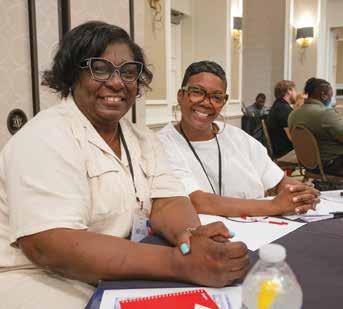
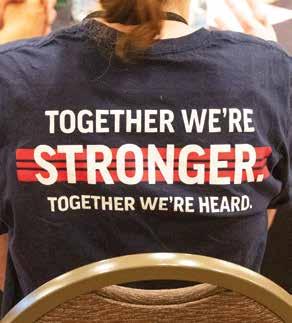

Summer School. After a full-day simulation exercise learning how to deal with school boards, community leaders, other organizations, and the media, VEA members left a totally-revamped Summer Organizing Institute in July with sharper skills and renewed enthusiasm for meeting their locals’ goals. The simulation featured school board and town hall meetings, walkouts, sign-making, chanting, and lots of strategizing. The three days of SOI also included panel discussions where members shared victories and challenges in their local fights for collective bargaining, sessions with various VEA departments to learn about available resources, and lots of networking and fun.
Chesapeake Education Association member
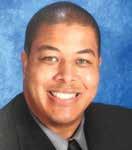
Al Alexander, an assistant principal at Western Branch High School, has been named the 2024 recipient of the National Education Association’s H. Councill Trenholm Memorial Award, honoring his outstanding work to help eliminate inequities based on race or ethnicity from public education. Al is the chairman of the New Chesapeake Men for Progress Education Foundation (NCMPEF), an organization instrumental in providing scholarships, grants, and mentoring services to students in need. Under his leadership, NCMPEF has provided nearly $200,000 in scholarships for high school students in Chesapeake, funded school supplies at city schools, and offered mini-grants to support initiatives serving local youth.ll


Life insurance benefits through the Virginia Retirement System help offer peace of mind, ensuring your family has financial support when you are no longer with them. You’re covered by the VRS Group Life Insurance Program from the first day of employment, and you’re also eligible to purchase additional life insurance for yourself, your spouse, and dependent children through the Optional Group Life Insurance Program.
Securian Financial offers Benefit Scout, an online tool to help you choose VRS optional group life insurance coverage to meet your needs. Insurance products are issued by Minnesota Life Insurance Co.
Access Benefit Scout on the optional life insurance education website at securian.com/vrs-insurance. You’ll also find information about coverage options, rates, beneficiary designations and the process for answering health questions. You’ll need to log in through your myVRS account, then select Life Insurance under My History, then click Visit Securian in the right-hand sidebar.
Some VRS life insurance benefits, including optional coverage under certain conditions, can continue into retirement. Visit varetire.org/ life-insurance for details.ll
VEA-Retired created the Martha Wood Distinguished Service Award to recognize retired VEA educators who, even after their working days are over, continue to make significant contributions to the growth of the active and retired Association, the promotion of public education, and the welfare of public educators. Many retirees have done this by providing hours of volunteer service in mentoring new teachers, lobbying lawmakers, and serving on national, state, and local committees. Help us identify outstanding retired members to consider for the 2025 honor, named for its first recipient, Martha Wood of Charlottesville, which will be presented at the VEA Delegate Assembly in Abingdon next spring. Send the name and address of deserving nominees, along with a brief description of their contributions, to Bea Snidow at VEA (by email at bsnidow@veanea.org or by mail at 8001 Franklin Farms Drive, Suite 200, Henrico, VA 23229). Nominations are due by Wednesday, January 8, 2025. Nominees must have been a member of VEA-Retired for at least five consecutive years as of January 15 of the award year, and cannot hold a current position on the VEA-Retired Council.l

Brittany Jones is an Organizing Specialist for Hampton Roads, bringing experience as a former teacher, Student VEA state president, NEA-Student Program Advisory Committee member, national conference presenter and member of the VEA Board of Directors.

Andrew (Andy) Thompson is the Valley UniServ Director. He’s a Valley native, recently retired middle school teacher after 27 years in the classroom, and former president of the Harrisonburg Education Association.l
Throughout the late summer of 2024, school divisions across the Commonwealth were busily bringing new staff members on board and holding New Employee Orientations to make that process a smooth one. Equally busily, local union members made their organization’s presence known at those NEO events, welcoming their newest colleagues and encouraging them to get on board with VEA. Check out these photos, taken at opening days in Albemarle, Chesterfield, Hampton, and Spotsylvania. l


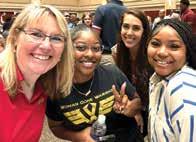

Let’s Do This — Together!
When I spoke at VEA’s convention this year, I asked our hundreds of delegates two questions: “Do you like what you’re doing?” and “Is what you’re doing important?” They’re crucial questions for all of us.



Don’t miss the latest issue of Teaching & Learning Today! This newsletter, produced by VEA’s Department of Teaching and Learning, helps you stay current on all the things T&L has in the works: opportunities available for our members, areas we’re focusing on, and future ventures. You can read current and back issues at www.veanea.org/professional-growth
If there are any instructional issues you’d like to discuss with us, we’d be happy to hear from you. Reach out through this email address: vea.workshops@veanea.org ll
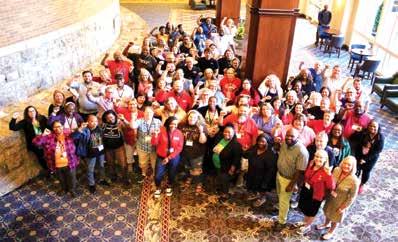
Here’s where I stand. Yes, I very much like what I’m doing and yes, what I’m doing is important. I’m excited to think how important our work is—we must be a voice and vision for all of Virginia’s students and educators. That excitement has helped me be involved in our union for almost three decades and, as I begin my time as VEA president, I’m even more excited to continue in that work.
We have a lot to do: I’ve appreciated hearing from fellow members about PE classes without special education support, science classes without enough equipment, and preschoolers who need more play time. As chair of VEA’s Resolutions Committee, I worked to keep us focused on important and timely issues like collective bargaining, school safety, and school funding. As chair of the VEA Women’s Caucus, I highlighted issues in a profession that is overwhelmingly female, such as raising compensation, protecting women’s rights, and ensuring that we support each other. And, as VEA vice president, advocated at school board meetings
across the state, in the General Assembly, and at the national level for Virginia’s educators.
As your president, I have no plans to stop.
We’re all advocates. I’m proud to be a NBCT, proud of the work I’ve done in the classroom, and proud of the work our members do every day. I’m here today because of the many educators who found purpose and fought important battles to bring equitable education to our schools. They spent their careers working to have a voice in the policies that impact our students, our members, and our communities. As it was for them, so it is for us: When things are difficult and seem insurmountable, we must remember that justice often needs a nudge, or even a shove. Together, we will not hesitate to nudge, shove, prod, push, and raise our voices. We will face challenges, but we’ll do it together.
I’m committed to making sure our members have the resources they need, and to making sure all our members are represented in our union. I’m honored to be your president, and I love being part of this family!l
Two VEA members have been chosen to be among NEA’s cohort of 2025 Global Learning Fellows. Through GLF, they’ll spend a year in online coursework, webinars, reading and reflection as well as in a two-day professional workshop and an international field study, all to help develop knowledge and skills to integrate global competency into their instruction. The 2025 field study will be in Costa Rica. Kristen Salonga of the Fairfax Education Association, a high school science teacher, and Stephen Straus of the Richmond Education Association, a middle school English teacher, were chosen through a nationwide process to join the 2025 GLF class and, afterward, will join an alumni group of more than 500 educators that supports continuing growth and leadership.
Fairfax Education Association member Lisa Zargarpur, an elementary school music and chorus teacher, will serve a second term as Vice Chair of the Prince William County School Board. She was first elected in 2019, representing the Coles Magisterial District, and was first chosen to serve as Vice Chair in 2021.
Education Association of Suffolk member Dr. Joleen Neighbours the city school system’s coordinator of fine and performing arts, has been named the Outstanding Administrator of the Year by the Virginia Music Education Association.
Lillian Brown of the Portsmouth Education Association is one of the winners of a national grant from the National Council for the Social Studies. She’ll be using the Grant for Enhancement of Geographic Literacy to create a project entitled “Get Lit with GeoLiteracy: Virginia Geographic Alliance GeoExplorer Institute.”l
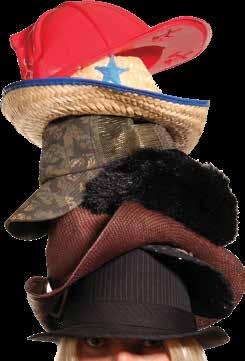
The many hats teachers wear.
By Joy Kirk
For an event in Winchester, I was asked to talk about the hats teachers wear and, as I prepared, I had a lot of questions. Is there a singular answer? Do we all wear the same hats? How can I begin to explain all the hats one could be wearing not just in a week, or even a day, but in just one moment? We’re constantly juggling hats depending on our students’ needs. Educators wear layer upon layer of hats, but here are a few of the critical ones in my wardrobe.
My primary hat is educator, teacher of young people. I impart knowledge and information to students, hoping to instill a sense of curiosity about the world and how it works. Whether they’re in elementary or middle school, gifted, English Language Learner, or in special education, I want all my students to learn how valuable they are and how to solve problems. I don’t want to give them answers; I don’t have all the answers. I want them to ask their own questions and seek solutions. Next, I am a healer. I spend part of every day healing. I see
and nurture physical, mental, and spiritual wounds. Over my 29 years of teaching, I’ve dried tears from playground scrapes and physical education falls. I’ve seen broken arms, concussions, and oh, the bruises. I’ve also dried the tears of losing a grandparent, a parent, a friend, and a pet. I’ve held and comforted students over the loss of first loves and promises broken. Helping students heal from wounds has to be a priority—you can’t focus on learning when you’re hurting inside.
I am also a nourisher. I provide knowledge to nourish my students’ minds, and I encourage them to read, listen, and explore to nourish their souls and find their authentic selves. I give them brain breaks and we move our bodies to make sure our physical and mental selves are ready to focus and learn. Nourishing and modeling how to take a break is critical for a healthy life balance.
Another hat I wear is provider. I am fortunate that I can provide for students when others are not or cannot. During my career, I have provided school supplies, snacks, field trip funds, and countless classroom materials. Those items are material necessities of school life, but more importantly I provide a safe place to shine. I provide a classroom where we believe in each student’s ability to grow. provide love, support, and encouragement to every child that crosses the threshold of my classroom
My most challenging hat is protector, because educators must do their best to protect young people from the harsh realities of our times, from abuses at home, from issues with peers, and even from themselves. must protect students from all harm—if they don’t feel safe, they cannot begin to learn. A classroom must be a safe place for all.
So, a teacher’s hat collection has to include numerous items. At any moment we might be teacher, counselor, nurse, confidant, parent, sibling, friend, comforter, provider, nourisher, healer, or protector; it’s all in the eyes of a young person. I try to be the person my students need each moment of the day, the person who can look at them and mean it when I say, “You are all bright shining stars capable of great things and I believe in the ability to succeed that dwells within each one of you.”l
Joy Kirk, a member of the Frederick County Education Association, is the county’s Parent Resource Center Specialist and the 2019 winner of VEA’s Award for Teaching Excellence.

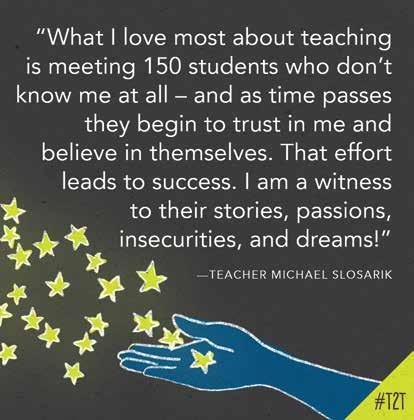
We’ll Never Outgrow the Human Element
Our humanity, as imperfect as it may be, is a gift to our students. In an age of A.I., our students still need a human to listen and empathize; to experiment and adapt; to make mistakes and apologize. They will need a guide who can build a relationship and help them navigate a complex world. Whether it’s a project-based learning unit or a class discussion, it is the teacher, as the artist, the problem-solver, and curator, who sparks innovation. The future of education can’t be found in a gadget or an app or a program or a product. It doesn’t require a think tank full of pundits. No, the future of education can be found in your classroom. Your classroom is packed with creative potential. You have all the innovation you need right there in your room. It’s what happens when you experiment. It’s what happens when you give your students voice and choice. It’s what happens when you abandon the scripted curriculum and take your students off-road in their learning. It’s what happens when you teach to your students rather than teaching to the test. It’s what happens when you unleash the creative power of all of your students — when you make the bold decision to let them make things and design things and solve problems that they find relevant.l

— Dr. John Spencer, author of The A.I. Roadmap: Human Learning in the Age of Smart Machines on why artificial intelligence can never replace teachers
The latest numbers on the 3.8 million full- and part-time public school teachers in the United States show that we still have a long way to go before our teaching force is more representative of our student population.
• 80 percent of public school teachers are White (compared with 46 percent of public school students who were White)
• 9 percent are Hispanic (compared with 28 percent of public school students who were Hispanic)
• 6 percent are Black (compared with 15 percent of public school students who were Black).l
Source: U.S. Department of Education’s Report on the Condition of Education 2024
“Kids are no different than adults. They’re no different than any human being.

The nonprofit organization We Need Diverse Books (diversebooks.org) offers these examples of the benefits children receive when they have access to age-appropriate books featuring diverse characters: seeing meaningful reflections of themselves and their environment; learning the true nature of the world around them; and benefiting from the richness of culture.
“When children cannot find themselves reflected in the books they read, or when the images they see are distorted, negative, or laughable, they learn a powerful lesson about how they are devalued in the society of which they are a part,” says Dr. Rudine Sims Bishop, who in 1990 wrote a widely-read article entitled “Mirrors, Windows, and Sliding Glass Doors” about the problem of our books not accurately depicting our culture.
WNDB points to a survey of 2,000 schools in which 90 percent of educators believed having books that feature diverse characters, realistically showing our student population, would help children become more enthusiastic readers.
While progress is being made, there is still this finding from the Cooperative Children’s Book Center: the percentage of children’s books depicting main characters from diverse backgrounds is lower than the number of books with main characters who are animals.l

When a human is connected to other individuals or to a location—or if they’re connected to a sport, a band, a certain class—they feel included and they feel seen, they feel heard, and they feel a part of what’s going on.”l
— David Arencibia, a middle school principal in Texas
When adults give positive reinforcement to teens, and it’s specific and sincere, it can be very effective in changing behavior, says school psychologist Rebecca Branstetter (tiktok. com/@thrivingstudents). She recommends using praise and corrective feedback in a 5:1 ratio, but adds this caution: With teenagers, praise is not often received as well if it’s made publicly, so try to offer both praise and corrective feedback in quieter, more private settings. For example, she notes, if you’re looking to regulate screen time in the classroom, praise can be as simple as saying to a student, “I haven’t seen you with your phone all day in my class.”l
Source: kqed.org


The Virginia Museum of History & Culture, located in Richmond, has launched Civics Connects, a statewide education program designed for students in the middle grades. Materials, which include lesson plans, interactive slides, video shorts, classroom activities, and special museum experiences, were created after years of research by VMHC and its John Marshall Center for Constitutional History & Civics.
Civics Connects resources are also tied to Virginia’s Standards of Learning and aligned with national standards. And they’re all available for free. To learn more, visit virginiahistory.org/learn/civics-connects l
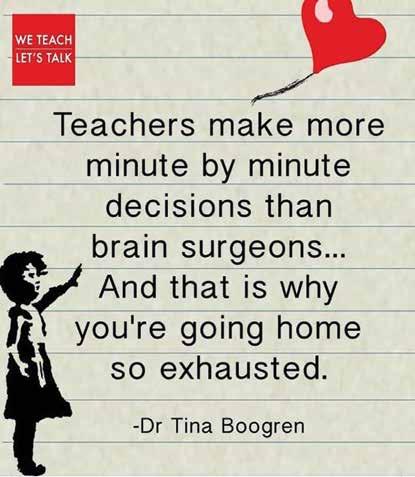
Since the human brain is attracted to novelty, try doing something unusual or unexpected to stimulate your students’ curiosity.

For example: Wear something unique, bring in an unusual object, or play a song when students enter the classroom to make them curious, and therefore focused. Tell students there’s a link between your clothes, the object, or the words to the song and something in the lesson. Invite them to guess what it is.
Another example: At the beginning of a unit on negative numbers, or on past tense in language, enter the room walking backward and then ask students to guess why.ll
Source: Edutopia

“As adults, what we post and say has real impact to our friends, family, and community. You represent more than a personal opinion when you’re an educator, a thought leader, a person in your community who is really driving thought and learning for those kids…It is so easy for us to fall into the traps of the algorithms and the platforms.”l
— Merve Lapus, vice president of education outreach and engagement at Common Sense, a nonprofit that provides media literacy information and curricula.






My wife and I live on rural land in Botetourt County, and just before school started this year, a wildlife biologist stopped by to set up a trail camera as part of an animal survey. While there, I told her that I’m a schoolteacher and would be starting back soon.
She replied that she had taught (in another state) but as a new teacher she had been given five preparations…all for collaborative classes. Many days, the 20-something said, she went home crying and then endured long nights of planning, anxiety, and little sleep. Finally, she told me, she decided that teaching “wasn’t for her.”
Trying to cheer her, I said a similar thing schedule-wise had been done to me back in the 1980s when I was with a different school system (for the past 35 years I’ve taught in Botetourt County). One of the most dispiriting acts came when my supervising teacher, who was head of the English department, took away my planning period and ordered me to take over her study hall from then on because she “had work to do.”
Later, an administrator threatened to fire me because my high number of students who had dropped out had pushed my failure rate to over 16 percent, the unacceptable percentage. Furthermore, the administrator continued, no other English teacher at the school had so many failures. I countered that should not be punished for all the variables that could cause a student to leave school, and that no other English teacher at the school had entirely lower level classes. My appeals went nowhere and feeling doomed, resigned at the end of the year. Actually, I felt
that I would never teach again and didn’t for two years, when I realized how much I missed the classroom and decided to give the profession one more try.
In an era when many school systems nationally and in Virginia are having difficulty finding new teachers, let alone keeping them, what are we doing and how can VEA members help the next generation of educators? For some possible answers, I called Dorothy Carter, Commonwealth Uniserv Director.
She told me that local associations, including mine, appoint mentors to new teachers to help them survive and hopefully thrive during that critical initial year. Conversations between a mentor and their mentee are confidential. This promise of confidentiality is helpful in easing the concerns and smoothing out the vicissitudes of teaching that so many young educators experience.
Another plus is the micro-credential program VEA/NEA offers on classroom discipline, math practices, arts education, cultural competence, and many other topics that can be found at this link: www.veanea.org/professional-growth/. When we first began teaching, many of us struggled with setting just the right classroom tone. These micro-credentials can help a beginning teacher. At the same link, you’ll also find VEA’s Learning Portal, offering a comprehensive lineup of professional learning courses. Carter also suggests reaching out to rookies, getting to know them and their interests, building a relationship, and involving them in the union. Help them feel that they belong and that they can make a difference in the lives of their students.
When I talk to beginning teachers, I tell them that I’ve been a VEA member for over 40 years. VEA organizes around such issues as the value of planning times, salaries, air quality, and negotiated contracts. Plus, the organization serves as our voice with school boards, boards of supervisors, and the state legislature about classroom needs.
Recently, I’ve been thinking a great deal about “my” wildlife biologist. While on my land, she told me how nice it is every day to spend time out in nature, but also how much she enjoyed sharing the natural world’s marvels with her students. She doesn’t miss the long, lonely nights of anguish and planning that many young teachers experience and she enjoys that she can spend more time with her husband and when we parted, she told me that she couldn’t see herself ever returning to the classroom.
And that’s a tragedy that occurs too often in Virginia and in our country. This fall, consider mentoring a young teacher at your school and/or at least be someone that he or she can talk to.l

